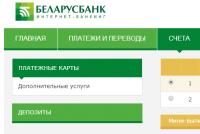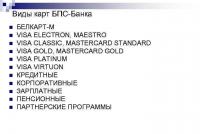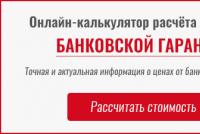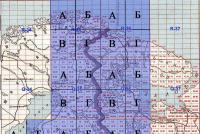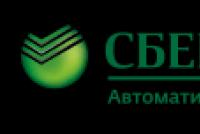General business expenses for the main production. How to keep accounting of overhead and general business expenses. Composition of general and general production expenses
overhead costs- this is account 25. Designed to summarize information on the costs of servicing the main and auxiliary industries organizations. In particular, the following expenses may be reflected in this account:
- maintenance and operation of machinery and equipment;
- depreciation deductions and expenses for the repair of fixed assets and other property used in production;
- expenses for insurance of said property;
- expenses for heating, lighting and maintenance of premises;
- rent for premises, machinery and equipment used in production.
Accounting and distribution of overhead costs
For a more accurate and justified allocation of costs to their intended purpose, it is extremely important to subdivide overhead costs depending on the place of their occurrence.
The costs of organizing production, management and maintenance are divided into shop, brigade, industry-wide (general production).
Brigade and workshop expenses are taken into account separately for each on-farm unit, and industry-wide - by industry. The brigade (shop, industry-wide) expenses include:
- labor costs with deductions for social needs of the administrative apparatus and other personnel whose functions are related to the organization of work in teams, in workshops and in the industry;
- expenses for the repair of fixed assets of general industry (brigade, workshop) purpose;
- other costs associated with the organization and maintenance of the production process in teams, in workshops and in the industry as a whole.
For these costs, a unified methodology for accounting and controlling costs is established: for each of their types, a planned estimate is drawn up with a division into articles. For synthetic accounting such expenses, the chart of accounts provides for an active, collective and distribution account 25 “General production expenses”, to which sub-accounts are opened as necessary. According to Dt 25 of the account during the reporting period, costs are collected at the end of the reporting period, general production costs are distributed in proportion to the selected distribution base and are included in the cost of specific types of products.
Brigade, workshop costs are included in the cost of only those products that are produced in the team, on the farm or in this workshop. Industry-wide costs are distributed and included in the cost of products manufactured in all major industries.
The specific distribution base must be fixed in the order for accounting policy. Distribution bases can be:
- wage workers of the main production;
- the amount of direct costs;
- planned output, etc.
When distributing overhead costs, an entry is made Dt 20 account for accounting for production costs Kt 25 the corresponding subaccount.
Was the page helpful?
More found about general production costs
- Cost accounting and costing of products in accordance with RAS and IFRS on the example of JSC AvtoVAZ General production expenses 26 General business expenses 28 Defective products 29 Service industries and farms 40
- Methods for calculating depreciation of intangible assets: approaches to the choice Auxiliary production 25 General production expenses 26 General business expenses 44 Selling expenses 97 Deferred expenses Regulatory documents
- Features of marginal analysis of profit and determination of the break-even point at enterprises of heavy engineering To overhead costs in addition to general production And general business expenses allocated commercial expenses t to according to the accounting policy of OJSC
- Essence and methodology for calculating gross and marginal profits In addition, the variable part is also included here. general production expenses Therefore, the cost of variable costs and direct costs will be different
- Depreciation of intangible assets: calculation and accounting Auxiliary production 25 General production expenses 26 General business expenses 44 Sales and other expenses Loan 97 Future expenses
- How to report on business segments Subsequently, it became clear that this article includes both general production and direct segment costs Segment spin-off The decision to spin off segments was supported by management B
- Anti-crisis management of the financial and economic stability of an industrial enterprise The use of an organizational and economic mechanism for managing financial and economic stability based on the integration of these systems over the specified period allowed the industrial enterprise to increase net revenue from the sale of goods products works services by 4.1% to reduce the cost of goods sold products works services by 1.5% including production costs - by 0.57% general production expenses - by 2.14% general running costs- 1.37% commercial
- Formation of estimated liabilities in accounting and tax accounting Service industries and farms 25 General production expenses 26 General expenses 44 Selling expenses Account credit 96 Provisions for future expenses
- Analysis of accounts payable on the lease payment D 20 Main production 25 General production expenses 26 General business expenses, etc. - K 60-1 Settlements with the lessor for leasing
- Management analysis of the costs of the enterprise general production overhead costs, but in fact they are of course related to the production of products Overhead costs -
- Budgeting in the enterprise management system When forming the consolidated budget for the planned period, the following stages of intra-company budgeting were sequentially performed; the target sales volume was determined; direct labor budget budget general production overhead budget business expenses budget management expenses developed financial and investment budgets of the enterprise
- Optimization of the structure of the balance sheet as a factor in increasing the financial stability of the organization general production and general expenses Average annual cost fixed assets for 2014 amounted to 129899 thousand rubles
- The need to take into account other income and expenses in marginal analysis The main areas for reducing fixed costs, in addition to revenue growth, are general production and general expenses improvement in the use of fixed assets, including reduction in equipment downtime
- Methodology for the audit of fixed assets Dm 25 Km 02 - 30964.48 rubles - depreciation was charged on other fixed assets general production destination Dm 26 Km 02 - 9709.68 rubles - depreciation was accrued on other main ... reporting period 2014 produced
overhead costs - represent the costs associated with the maintenance, organization and management of the main, auxiliary and service industries. These expenses include:
- Maintenance and operation of machinery, equipment;
- Depreciation;
- Funds spent on the repair of property that was used in production;
- Costs for heating, lighting and other maintenance of premises;
- Expenses for renting the premises;
- Labor costs of employees who are engaged in servicing production;
Accounting for the amount of overhead costs occurs on the debit of account 25 “General production costs” from the credit of accounts for accounting for production inventories, settlements with employees for wages, etc. - Dt 25 Kt 02, 05, 10, 21, 60, 76, 70, 69 ...
Expenses accumulated on account 25, following the results of the month, are subject to debit of accounts 20 “Main production”, 23 “Auxiliary production” and 29 “Service production and farms”. The order of their distribution according to these accounts is established by each organization individually, for example, based on direct production costs or the amount of employees' salaries.
After establishing the procedure for the distribution of costs, it must be fixed in the accounting policy of the organization.
Postings for writing off general production expenses:
- Dt 20 Kt 25 - write-off of overhead costs related to the activities of the main production;
- Dt 23 Kt 25 - write-off of overhead costs related to the activities of auxiliary production;
- Dt 29 Kt 25 - write-off of overhead costs related to the activities of the service industry;
Analytical accounting for these costs is carried out for each shop in the relevant cost accounting sheets of the shops in form No. 12. The basis for filling out these sheets is primary documents and developed tables for the distribution of materials, wages, auxiliary production services, etc.
General running costs These are costs that are not related to the production process. These expenses include:
- Administrative and managerial;
- For the maintenance of general economic personnel;
- Depreciation;
- Funds spent on the repair of fixed assets, managerial and general business purposes;
- The cost of renting premises for general economic purposes;
- Expenses for payment of audit, information, consulting and other services;
- Other expenses similar in purpose.
Accounting for the amount of general business expenses occurs on the debit of account 26 “General business expenses” from the credit of accounts for accounting for production inventories, settlements with employees for wages, settlements with other organizations (persons), etc. - Dt 26 Kt 02, 05, 10, 21, 60, 76, 70, 69…
Analytical accounting for these expenses is carried out in the relevant statements of accounting for general business costs, as well as deferred expenses and expenses not related to the production process in form No. 15. The basis for filling out these statements is the primary documentation and developed tables.
Write-off of general expenses depends on cost formation method:
1. In the case of accounting for finished products in full production cost, expenses previously taken into account on account 26 are subject to debit of accounts 20 “Main production”, 23 “Auxiliary production” and 29 “Serving production and farms” (if these productions provided services to third-party organizations). The procedure for the distribution of costs for these industries is established by each organization individually and is fixed in its accounting policy.
General production and general business expenses. The main method of accounting for production costs construction works is the so-called order-by-order method, in which the object of accounting is a separate order.
It is opened for each construction site in accordance with the contract concluded with the customer. That is, accounting should be built in such a way that information on income and expenses is provided for each contract.
Recall that by the method of inclusion in the cost price construction products production costs are divided into direct and indirect.
Direct costs are directly related to a specific construction object - this is the cost of raw materials and materials, the amount of wages of production workers along with social contributions, depreciation of equipment and other costs that can be attributed to the cost of production based on primary documents.
Indirect costs are not directly related to the production of a particular type of product, and therefore cannot be attributed to its cost directly, but are distributed indirectly (that is, conditionally).
Indirect costs are preliminarily taken into account in the collective distribution accounts accounting(on account 25 “General production expenses”, on account 26 “General expenses”, etc.) and are distributed among accounting objects in proportion to the indicators provided for accounting policy, using pre-calculated coefficients.
IN construction industry for determining indirect costs the term "overhead" is commonly used. Their list is presented in the Guidelines for determining the amount of overhead costs in construction (MDS 81-33.2004), and accountants are often guided by it. construction companies to classify the costs incurred.
But we draw attention to the fact that in these Guidelines (Appendix 6) there is a list of costsincluded in the article "Overhead costs" when compiling budget documentation and the formation of contractual prices for the construction of facilities (administrative and economic expenses, expenses for servicing construction workers, expenses for organizing work on construction sites etc.).
In accounting, the classification is different, and when attributing certain overhead costs to general production or general business, one must be guided by accounting standards.
The procedure for the formation and distribution of expenses
General production and general business expenses. Accounting and tax accounting the costs involved are different. Let's dwell on them in more detail.
Accounting
General production expenses. According to the Chart of Accounts ... (approved by order of the Ministry of Finance of Russia dated October 31, 2000 No. 94n), account 25 is intended to summarize information on the costs of servicing the organization's main and auxiliary production facilities. It may reflect:
- costs for the maintenance and operation of machinery and equipment of the organization;
– depreciation deductions and expenses for the repair and insurance of fixed assets and other property used in production;
– expenses for heating, lighting and maintenance of industrial premises;
- rent for premises, machines, equipment used in production;
- remuneration of workers engaged in maintenance of production;
- other similar expenses.
Thus, in accounting, overhead costs include the costs of organizing production and managing individual areas of production and departments, as well as production costs that cannot be attributed directly to a particular calculation object, since they relate to the type of activity or to the production department as a whole. .
The main criterion for classifying costs as general production costs is the impossibility of direct inclusion of production costs in the cost of construction and installation works under a specific contract.
When accounting for costs, attention should be paid to some more features established by PBU 2/2008.
Thus, the costs under the contract include costs directly related to its preparation and signing, if they can be reliably determined and if there is a possibility of signing the contract in the reporting period of their occurrence (clause 15 PBU 2/2008). If these conditions are not met, these expenses are recognized as other expenses of the period in which they were incurred. This applies to the costs incurred by the organization before signing the contract for the development of a feasibility study, the preparation of an insurance contract for the risks of construction work, etc.
The composition of the costs can be clarified according to IFRS
Specific types of indirect costs are not established in PBU 2/2008. Unlike the Russian international standard deciphers their composition. In particular, IFRS 11 Work Contracts (paragraph 18) states that to indirect costs relate:
– insurance payments(except for insurance payments, payments for the provision of guarantees and guarantees made specifically under a specific contract, which should be attributed to direct expenses);
- design and construction costs technical support not directly related to a specific contract;
- overhead costs of construction;
- the cost of loans and borrowings.
This list can also be used for the purposes of Russian accounting.
Such a possibility (in the absence of relevant norms in Russian legislation) is provided for in paragraph 7 of PBU 1/2008 "Accounting Policy of the Organization" (approved by order of the Ministry of Finance of Russia dated October 6, 2008 No. 106n).
And more - about the time of recognition of expenses. In accordance with clause 16 of PBU 2/2008, contract costs are recognized in the reporting period in which they are incurred. In this case, the costs related to the work performed under the contract are accounted for as production costs. And the expenses incurred in connection with the forthcoming work - as expenses of future periods.
tax accounting
There is no requirement for “object-based” accounting in tax regulations.
The organization approves the list of direct expenses in the accounting policy for tax purposes (Article 318 of the Tax Code of the Russian Federation).
For the convergence of accounting and tax accounting, it is advisable to set the composition of direct costs the same.
Please note that although the list provided in paragraph 1 of this article ( material costs, wages, depreciation) is not mandatory, it is not recommended to reduce it, it is better to stick to this minimum set.
Otherwise, the organization should try to justify its choice in advance.
All other costs associated with the production and sale (with the exception of non-operating expenses determined in accordance with Article 265 tax code RF, which were carried out by the organization during the reporting or tax period) will be indirect.
It is not required to allocate them to the balance of work in progress, as direct costs. In tax accounting, they are immediately written off as a reduction. tax base current period (
overhead costs- these are all indirect (indirect) costs of the organization associated with the production of this unit of output. They are also called production overheads, factory overheads, indirect production costs, general expenses.
The main groups of overhead costs are:
The cost of auxiliary materials and components;
Indirect labor costs;
Expenses for the maintenance of buildings, maintenance and current repairs of equipment;
Property taxes;
Property insurance;
Public utilities;
Rent;
- depreciation deductions for buildings, equipment, intangible assets.
Part of the overhead costs (for example, the consumption of electricity, tools) varies in proportion to the volume of production and are variable production costs. Some overhead costs are fixed (for example, insurance premiums, rent). Since the dependence of indirect costs on production volumes is complex, ambiguous, they are often divided not into variable and fixed costs, but into conditionally variable, conditionally fixed costs.
General production expenses (account 25 in the standard chart of accounts) are allocated by production organizations with a shop management structure. Organizations with a non-shop production management structure can take into account the above expenses as part of general business expenses (on account 26).
The normative value of general production and general business expenses is determined on the basis of the data of the base year.
General production costs are determined for each production workshop (section) that produces finished products taking into account these costs of all allied workshops.
Then it is determined specific gravity each element of costs in the total amount of overhead costs and a conditionally constant part in them.
The conditionally fixed part in the total amount of overhead costs includes:
Fuel and thermal energy for heating, materials, expenses for the maintenance of buildings and other works, except for those used for the repair of fixed assets of the workshop;
The basic and additional wages of managers, specialists, employees and time workers for servicing the fixed assets of the workshop, deductions for social needs;
Depreciation deductions for the full restoration of fixed assets in accordance with applicable standards;
Depreciation of low-value and wear-out inventory of the workshop.
List of cost elements of overhead costs includes:
1. Material costs:
1.1. lubricating, cleaning and other materials necessary for the care of equipment and vehicles and their maintenance in working order;
1.2. materials necessary for the economic needs of workshops (maintenance of electrical networks, heating networks, water supply, sewerage and ventilation), maintenance of buildings and structures;
1.3. spare parts and other materials for the repair of production equipment, Vehicle, buildings and structures;
1.5. services of third-party organizations for the maintenance and repair of equipment, vehicles, buildings, structures, work on labor protection and safety, as well as outsourced transport to move materials and semi-finished products from base warehouses to processing shops;
1.6. materials necessary for the implementation of experiments, research, testing, rationalization proposals, inventions;
1.7. materials necessary for labor protection and safety;
1.8. overalls, special footwear, protective devices given free of charge to employees, as well as the cost of milk and other neutralizing substances;
1.9. other workshop materials.
2. Thermal energy from the outside, consumed for the actuation of machines and mechanisms that are not part of the main technological equipment, as well as for economic needs. Thermal energy of own generation is accounted for in the cost by cost elements.
3. Basic and additional salary:
3.1. managers, specialists and employees of the shop;
3.2. shop workers servicing production equipment, engaged in various chores, repairing equipment, buildings, structures, performing experiments, research, work on the implementation of inventions and rationalization proposals, on labor protection and safety, cleaning and other works.
4. Deductions for social needs from the wages of employees listed in paragraph 3, according to established standards.
5. Depreciation deductions for the full restoration of fixed assets and not tangible assets workshops.
6. Other costs, not provided for in clauses 1-5, associated with the maintenance and operation of the workshop's fixed assets.
For inclusion in the calculation of overhead costs in organizations, the standard for overhead costs is calculated:
where: Nopr - the standard of overhead costs,%;
ΣOPR bases (report) - the amount of overhead costs of the base (reporting) period, rub.;
ΣOZP base (otch) - the amount of the basic salary of the base (reporting) period, rub.
Standard for overhead costs calculated in each organization based on the data of the previous year (reporting period). When an organization is formed and there is no reporting data for the base (reporting period), a planned calculation of overhead costs is compiled and a planned standard for overhead costs is formed.
When compiling a cost estimate for a unit of production, the amounts of overhead costs are included in the cost as follows:
DEFl.pr. = Ndef x OZPed.pr., (9)
DEFl.pr. - the amount of overhead costs to be included in the cost of a unit of production, rub.;
OZPed.pr. - the basic wages of workers, taken into account as part of the direct costs of producing a unit of output, rub.
General production costs are classified as indirect, indirect costs.
Their records should be maintained in each department of the enterprise.
General production costs are included in the production cost of manufactured products.
Such expenses include:
- Depreciation of fixed assets of production.
- Depreciation of other non-current tangible assets involved in the work of the management department.
- The cost of fuel and electricity used in the operation of the equipment.
- The cost of spare parts and materials needed to repair equipment. This item does not include expenditures related to the improvement and modernization of means of production.
- The cost of low-value and wear-out items that were used for production and management needs.
- Defective goods.
- Unforeseen and implicit labor costs.
Types and calculation of overhead costs
This type of cost can be variable or fixed.
The variable type includes costs proportional to the growth of production turnover.
This is due to an increase in the wear rate of equipment, the need to increase the power of the devices and the resulting energy costs.
Growth in costs can be in direct proportion to the increase in production volumes, inversely, or increase ahead of schedule.
Fixed overhead costs include expenses that are unchanged or little subject to change with an increase in the volume of activity, they are associated with managerial and accounting work.
The general indicator of overhead costs is the sum of the following indicators:
Annual depreciation of fixed capital.
It is determined by the amount of monetary assets spent on the complete restoration of all means of production and the administrative apparatus.
It is calculated by the formula:
A \u003d (PS * Na) / 100,
where A is depreciation, PS is the initial cost of equipment and other assets, Na is the depreciation rate.
The cost of raw materials and materials.
The formula is used to calculate:
P \u003d K * ∑ (N * C),
where P is the total cost level, H is the cost rate, P is the price of the material needed to repair or maintain equipment (energy), and K are transportation costs.

